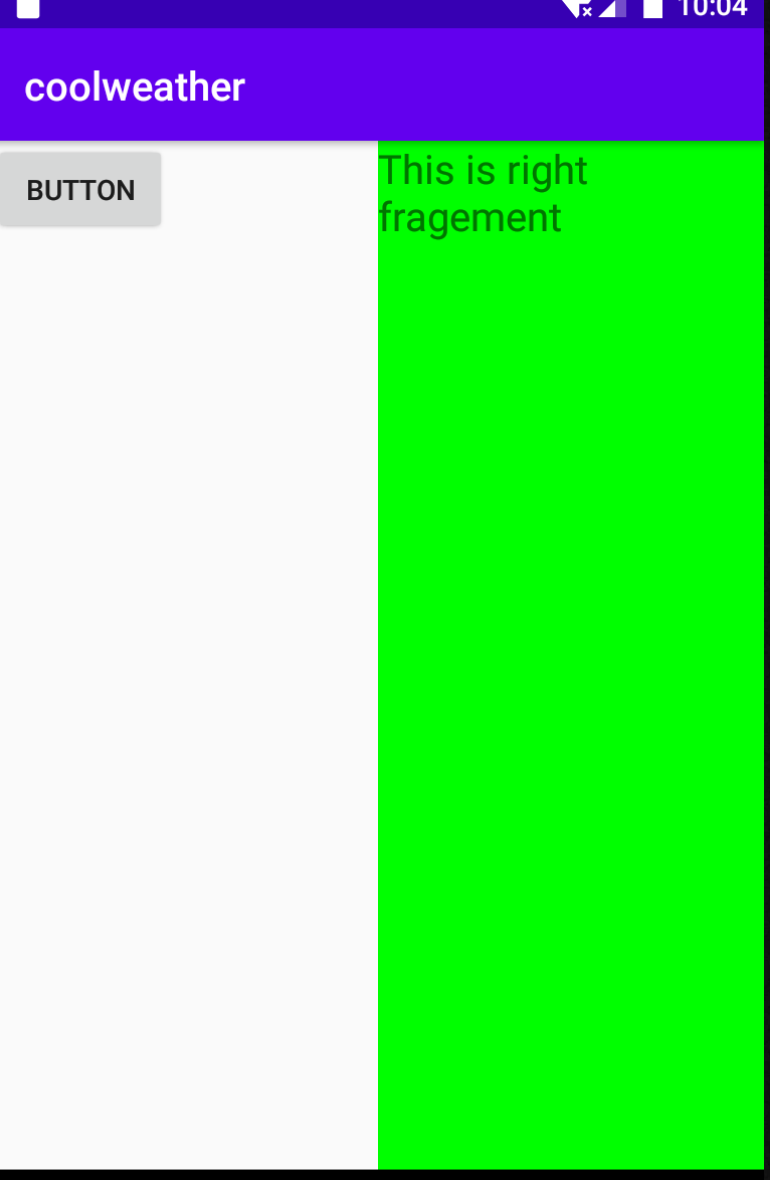安卓开发--探究碎片Fragment
简述:
最近做开发的时候又遇到了Fragment,发现太久没写,都快忘了,就抓紧写个笔记(我太懒的了233)
Fragment可以简单的看成迷你的活动,它和活动一样都有布局和生命周期,它可以嵌入活动之中,
这样在活动的这个大布局中,还可以嵌入碎片的布局,那么app的功能就可以多样化,实现碎片的方式也
很简单,因为碎片是个迷你的活动,那么肯定得和活动一样,搭配一个布局文件,所以做法是先创建
对应碎片的布局文件,然后新建碎片类继承Fragment类,把碎片布局加载进来,然后再把这个碎片
加载到对应我们想要嵌入的活动中,因为碎片表现形式还是布局,所以我们是在活动的布局文件中
加入碎片,加载碎片的。
0x01:简单使用
新建两个布局文件,Left_fragment和Right_fragment.xml,
<?xml version="1.0" encoding="utf-8"?> <LinearLayout xmlns:android="http://schemas.android.com/apk/res/android" android:layout_width="match_parent" android:layout_height="match_parent"> <Button android:layout_width="wrap_content" android:layout_height="wrap_content" android:id="@+id/button" android:layout_gravity="center_horizontal" android:text="Button"/> </LinearLayout>
<?xml version="1.0" encoding="utf-8"?> <LinearLayout xmlns:android="http://schemas.android.com/apk/res/android" android:orientation="vertical" android:background="#00ff00" android:layout_width="match_parent" android:layout_height="match_parent"> <TextView android:layout_width="wrap_content" android:layout_height="wrap_content" android:layout_gravity="center_horizontal" android:textSize="20sp" android:text="This is right fragement"/> </LinearLayout>
然后新建两个碎片类,继承Fragment,
package com.example.coolweather; import android.os.Bundle; import android.view.LayoutInflater; import android.view.View; import android.view.ViewGroup; import androidx.fragment.app.Fragment; public class LeftFragment extends Fragment { public View onCreateView(LayoutInflater inflater, ViewGroup container, Bundle saveInstanceState) { View view=inflater.inflate(R.layout.left_fragment,container,false); return view; } }
package com.example.coolweather; import android.os.Bundle; import android.view.LayoutInflater; import android.view.View; import android.view.ViewGroup; import androidx.fragment.app.Fragment; public class RightFragment extends Fragment { public View onCreateView(LayoutInflater inflater, ViewGroup container, Bundle savedInstanceState) { View view =inflater.inflate(R.layout.right_fragment,container,false); return view; } }
重写一个Fragment类中的onCreateView方法,通过inflater.inflate加载碎片的布局,
然后最后就是将碎片嵌入到我们想要的活动之中(以布局的形式,所以还是在xml文件中加入)
<?xml version="1.0" encoding="utf-8"?> <LinearLayout xmlns:android="http://schemas.android.com/apk/res/android" android:layout_width="match_parent" android:layout_height="match_parent"> <fragment android:id="@+id/left_fragment" android:name="com.example.coolweather.LeftFragment" android:layout_width="0dp" android:layout_weight="1" android:layout_height="match_parent" /> <fragment android:layout_width="0dp" android:layout_height="match_parent" android:layout_weight="1" android:id="@+id/right_fragment" android:name="com.example.coolweather.RightFragment" /> </LinearLayout>
然后打开模拟器就可以看到对应的效果了。

二.动态添加碎片,
新建另一个碎片布局文件,并创建碎片类,加载碎片布局
<?xml version="1.0" encoding="utf-8"?> <LinearLayout xmlns:android="http://schemas.android.com/apk/res/android" android:layout_width="match_parent" android:orientation="vertical" android:background="#ffff00" android:layout_height="match_parent"> <TextView android:layout_width="wrap_content" android:layout_height="wrap_content" android:layout_gravity="center_horizontal" android:textSize="20sp" android:text="This is another right fragment" /> </LinearLayout>
package com.example.coolweather; import androidx.appcompat.app.AppCompatActivity; import androidx.fragment.app.Fragment; import androidx.fragment.app.FragmentManager; import androidx.fragment.app.FragmentTransaction; import android.content.Intent; import android.os.Bundle; import android.view.View; import android.widget.Button; import java.nio.channels.InterruptedByTimeoutException; public class MainActivity extends AppCompatActivity { @Override protected void onCreate(Bundle savedInstanceState) { super.onCreate(savedInstanceState); setContentView(R.layout.layout); Button button=(Button)findViewById(R.id.button); button.setOnClickListener((View.OnClickListener) this); } public void onClick(View v) { switch(v.getId()) { case R.id.button: replaceFragment(new AnotherRightFragment()); break; default: } } private void replaceFragment(Fragment fragment) { FragmentManager fragmentManager=getSupportFragmentManager(); FragmentTransaction transaction=fragmentManager.beginTransaction(); transaction.replace(R.id.right_layout,fragment); transaction.commit(); } }
replacefFragment这个方法是动态加载碎片的关键,先是调用getSupportFragmentManager()这个方法
返回FragmentManager对象,再通过FragManager对象调用beginTransaction开启事务,然后调用
replace方法,第一个参数是容器的id,第二个参数是碎片的实例,就可以了,运行代码就有效果出现了。
另外如果需要点击back按钮返回到上一个碎片的,话要额外再加一句代码,在replaceFragment中多加
一句就好了。
private void replaceFragment(Fragment fragment) { FragmentManager fragmentManager=getSupportFragmentManager(); FragmentTransaction transaction=fragmentManager.beginTransaction(); transaction.replace(R.id.right_layout,fragment); transaction.addToBackStack(null) transaction.commit(); }


 浙公网安备 33010602011771号
浙公网安备 33010602011771号